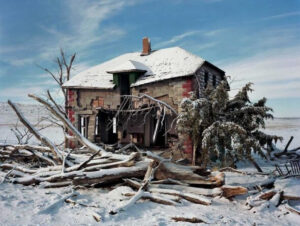
When Twin Peaks premiered on April 8, 1990, American television was abruptly pried open like the log of a Douglas fir. From that splintering emerged a dreamlike narrative that defied categorization, created by the surrealist filmmaker David Lynch and the novelist-screenwriter Mark Frost. What appeared to be a standard who-dun-it about the murder of a small-town prom queen quickly unfurled into a feverish fable of desire, duplicity, and darkness. In its original two-season run on ABC and its 2017 third-season revival on Showtime, Twin Peaks evolved from a cult phenomenon into a foundational text in the canon of postmodern television, not merely reflecting culture but unsettling it from the inside.
A Fire Walk With Premise: Plot as Portal
At its outset, Twin Peaks posed a simple question: “Who killed Laura Palmer?” But that question served only as an invitation, a velvet curtain leading viewers deeper into the diabolical woods of the human psyche. Laura—beautiful, blonde, popular, and secretly broken—wasn’t merely a murder victim; she was the town’s subconscious, torn open and left to bleed in public. What unfolded across the show’s episodes was not just a mystery but a metaphysical excavation.
FBI Special Agent Dale Cooper, played with meditative eccentricity by Kyle MacLachlan, functioned less as an investigator than a spiritual medium, decoding symbols as much as clues. His love of cherry pie and “damn fine coffee” provided comedic ballast to a narrative freighted with incest, demonic possession, and an omnipresent evil known simply as BOB. By the third episode, the show had already abandoned reality’s borders, dropping Cooper into The Red Room—a monochrome purgatory peopled by backwards-speaking spirits and Lynchian metaphors incarnate.
To this day, there is no mainstream analog for the show’s tonal elasticity. One moment you’d be watching a soap opera pastiche at the Double R Diner; the next, you’d find yourself facing the abyss of trauma in the Palmer living room. It was a show that could, without contradiction, include a dancing dwarf and an interdimensional investigation into the corruption of innocence.
Lynch, Frost, and the Alchemy of Narrative Experimentation
Lynch, fresh off the critical volatility of Blue Velvet (1986), brought his obsessions with small-town façades, grotesquerie, and suburban dread. Frost, with roots in network-friendly storytelling, grounded Lynch’s abstractions in character arcs and coherence. Together, they composed a world where symbols had the weight of gospel.
As Frost shared in a 2025 interview, “Once we had created the infrastructure for the town and populated it with characters, we wrote the pilot in three weeks. We hardly changed a word after that.” The spontaneity was embedded in the show’s DNA, but so was precision. “It poured out of us,” he added, “almost exactly as what you see when you watch it.”
That raw creative gush stood in stark contrast to the televisual orthodoxy of the late ’80s and early ’90s. Until Twin Peaks, prime-time TV was dominated by procedurals, family dramas, and laugh-track sitcoms. Its nearest contemporaries—Dallas, Moonlighting, Hill Street Blues—may have flirted with experimentation, but none dared risk coherence for poetry.
Strange and Getting Stranger: Surrealism Enters the Living Room
That Twin Peaks reached the heights it did, in terms of both audience and acclaim, remains one of American pop culture’s great anomalies. “The Pilot” drew 34 million viewers—roughly one in every eight Americans at the time. By the end of the first season, Saturday Night Live parodied it, critics praised it, and fans pored over clues as if decoding scripture.
Yet the show’s confidence in its own strangeness never wavered. Lynch introduced dream sequences filmed in reverse, a one-armed man who quotes biblical prophecy, and a giant who speaks in riddles. These surreal elements weren’t indulgent non-sequiturs—they were fragments of a larger metaphysical architecture. The mythology of the Black Lodge, The White Lodge, and “The Dweller on the Threshold” hinted at a cosmic war far greater than mere homicide.
Despite—or because of—its dream logic, the show tapped into something deeply familiar: the perverse symmetry of nightmares and the duality within all people. It suggested that evil wasn’t external or abstract, but intimate and inherited. That, ultimately, was Twin Peaks’ most radical assertion.
Laura Palmer: The Sainted Victim, The Silenced Voice
Laura Palmer, played by Sheryl Lee, has become a cultural sigil—her Homecoming Queen photograph synonymous with unspeakable suffering masked by perfection. But while she is initially the mystery’s MacGuffin, Lynch and Frost slowly grant her voice, agency, and complexity—particularly in the 1992 prequel film Fire Walk With Me.
This film, hated by critics upon release but later revered, chronicled the final week of Laura’s life. What it revealed was both more terrifying and more human than anything seen in the series. Here was the girl under the plastic wrap—an addict, an abuse survivor, a teenager screaming into the void. Lynch didn’t just imply the trauma—he made audiences live in it. The film functions like a cinematic dirge, honoring Laura not as a symbol, but as a martyr.
In hindsight, Fire Walk With Me is Twin Peaks’ emotional nucleus. It clarified the show’s deepest concern: the way trauma replicates itself across generations, masked by pageantry and politeness. No ghost, no demon, was more terrifying than a parent’s betrayal. In presenting incest and predation through symbolic possession, Lynch cloaked horror in allegory—yet never allowed the core truth to be buried.
Season Three: A Return, Not a Revival
When Showtime announced in 2014 that Twin Peaks would return for an 18-episode third season, fans erupted in cautious jubilation. But what Lynch and Frost delivered in 2017 wasn’t comfort or closure—it was challenge. The Return, as it came to be known, is arguably Lynch’s most uncompromising work.
Far from a nostalgic victory lap, Season Three obliterated expectations. It introduced doppelgängers, dimension-hopping atomic origin stories, glitching timelines, and unresolvable questions. Cooper spent much of the season as Dougie Jones, a near-catatonic vessel in a suit. Whole episodes unfurled with no discernible arc. Episode 8, which aired on June 25, 2017, became a landmark in television surrealism—a nearly silent, black-and-white abstraction that chronicled the birth of evil through the 1945 atomic test at White Sands.
What The Return demanded was patience. Its rewards were not episodic, but accumulative. Its impression was cumulative. This was television not as entertainment, but as ritual.
Cultural Reverberations: The Long Darkened Cast of Twin Peaks
The DNA of Twin Peaks runs through the contemporary media landscape like a glacial river under snow. The X-Files, Lost, True Detective, Stranger Things, and The OA are all touched by its influence. It made room for shows that didn’t explain themselves. It told studios that audiences could handle abstraction. It also allowed future auteurs—Noah Hawley, Sam Esmail, Damon Lindelof—to believe that television could be cinematic and poetic.
Even outside media, its cultural echoes persist. There’s an entire sub-industry of Twin Peaks merchandise, memes, art exhibitions, and academic symposia. The Double R Diner’s cherry pie became as iconic as Proust’s madeleine. Fashion brands borrowed its iconography. Musicians referenced it—Angelo Badalamenti’s haunting score remains one of the most recognizable in television history.
More profoundly, it initiated a shift in the way audiences approached meaning. We began watching less for plot than for sensation. For texture. For mood.
Impression
The last episode of The Return ends with a question: “What year is this?” Cooper stands in front of a house that is no longer Laura Palmer’s. Time has collapsed, or rewritten itself. The scream that follows—Laura’s, or Carrie Page’s, or maybe the audience’s—cuts to black. There is no resolution.
But Twin Peaks was never meant to resolve. It was meant to disrupt. To haunt. To rewire how we dream. “The world of Twin Peaks,” Lynch once said, “is a world where a lot of things go on beneath the surface.”
In that sense, Twin Peaks is not about finding answers, but embracing mystery. It is not a show to be solved, but inhabited—like a lodge where the curtains whisper and the owls keep secrets.
No comments yet.








